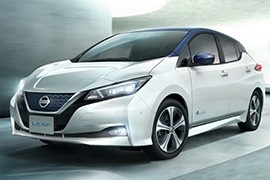
NISSAN Leaf
Generations Timeline, Specs and Pictures

The second generation Nissan Leaf was unveiled in September 2017 showing up with a more futuristic look that entirely got rid of the previous ‘squished frog’ appearance.
Leaving the awesome edgy design aside, the new Leaf can also go further on a single charge and has more power and torque than before. The new Nissan LEAF features three main new intelligent driving technologies. The first is ProPILOT advanced driver assistance system. Used during single-lane driving on the highway, it makes the drive easier, less stressful and more relaxing.
The second, ProPILOT Park, will change the way people think about parking. When activated, this technology will take control of all steering, acceleration, braking and gear selection to automatically guide the car into a parking spot. It makes parking stress free and more precise for all drivers.
The third, e-Pedal, is a revolutionary technology that transforms the way we drive. It allows drivers to start, accelerate, decelerate and stop simply by adjusting their input upon the accelerator pedal. When the accelerator is fully released, regenerative and friction brakes are applied automatically, gradually bringing the car to a complete stop. The car holds its position, even on steep uphill slopes, until the accelerator is pressed again. The reactiveness of e-Pedal enables drivers to maximize their driving pleasure when the road opens up.

The first generation of the Leaf was a big punch against the internal combustion car market.
Even though it wasn’t the first electric car, it was the first that mattered.
After a few delays in production, the first Nissan Leaf was launched in 2010. To make the car appealing, it was marketed as a compact hatchback vehicle. It was launched at the same time in Japan and in the U.S. It was the first affordable electric vehicle that could run 160 km (100 miles) on one charge and it could have been recharged from a regular power outlet at home. The charging stations were a dream in 2010.
The car featured a futuristic look, with a sloped front and a high greenhouse. The headlights were installed closer to the A-pillars to protect them from small city crashes. In the front, where the normal cars had the radiators, the Leaf had the charging point behind the Nissan badge. The side view of the windows looked like a leaf.
Inside, the revolutionary design was noticed at the instrument cluster, where the dials were replaced by a TFT display. The speedometer was on a separate display placed on top of the dashboard. On the center stack, a big touch-screen was introduced to control various features of the car. The “gear-stick” was a rotary knob between the seats. In the back, there was enough room for three adults. Since the battery pack was placed underneath the floor, the seating position was higher than in a normal hatchback.
The 2010 Leaf was powered by an 80 kW motor. The standard battery pack could get 24 kWh energy. In late 2016, it was upgraded to a 30 kWh battery pack.























































